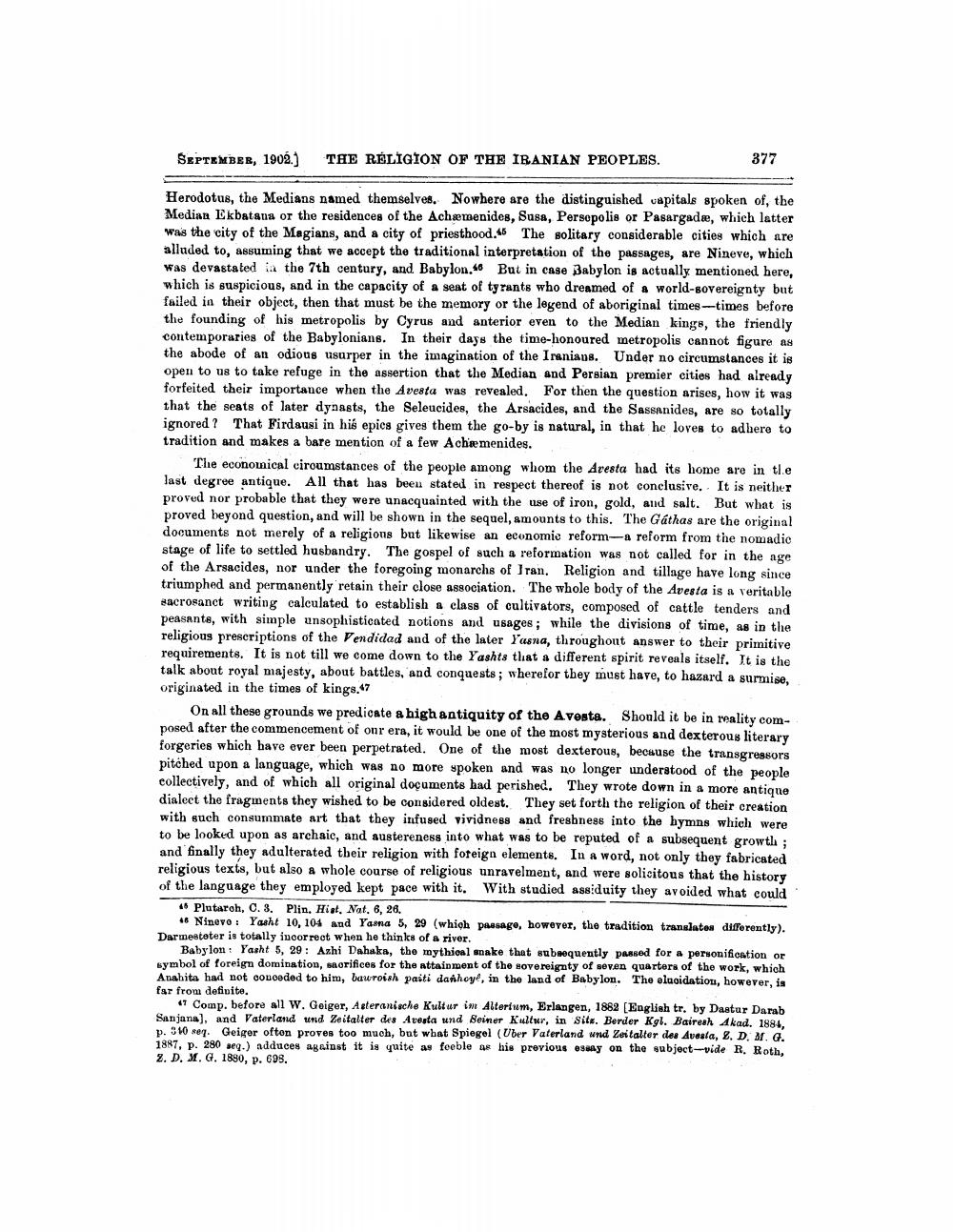________________
SEPTEMBER, 1902.)
THE RÉLIGION OF THE IRANIAN PEOPLES.
377
Herodotus, the Medians named themselves. Nowhere are the distinguished vapitals spoken of, the Median Ekbatana or the residences of the Achæmenides, Susa, Persopolis or Pasargada, which latter was the city of the Magians, and a city of priesthood. The solitary considerable cities which are alladed to, assuming that we accept the traditional interpretation of the passages, are Nineve, which was devastated ia the 7th century, and Babylon 56 But in case Babylon is actually mentioned here, which is suspicious, and in the capacity of a seat of tyrants who dreamed of a world-Bovereignty but failed in their object, then that must be the memory or the legend of aboriginal times--times before the founding of his metropolis by Cyrus and anterior even to the Median kings, the friendly contemporaries of the Babylonians. In their days the time-honoured metropolis cannot figure as the abode of an odious usurper in the imagination of the Iranians. Under no circumstances it is open to us to take refuge in the assertion that the Median and Persian premier cities had already forfeited their importance when the Avesta was revealed. For then the question arises, how it was that the seats of later dynasts, the Seleucides, the Arsacides, and the Sassanides, are so totally ignored ? That Firdausi in his epies gives them the go-by is natural, in that he loves to adhere to tradition and makes a bare mention of a few Achæmenides.
The economical ciroumstances of the people among whom the Aresta had its home are in the last degree antique. All that has been stated in respect thereof is not conclusive. It is neither proved nor probable that they were unacquainted with the use of iron, gold, and salt. But what is proved beyond question, and will be shown in the sequel, amounts to this. The Gáthas are the original documents not merely of a religions but likewise an economic reform--a reform from the nomadic stage of life to settled husbandry. The gospel of such a reformation was not called for in the age of the Arsacides, nor under the foregoing monarchs of Iran. Religion and tillage have long since triumphed and permanently retain their close association. The whole body of the Apesta is a veritable sacrosanct writing calculated to establish a class of cultivators, composed of cattle tenders and peasants, with simple unsophisticated notions and usages; while the divisions of time, as in the religious prescriptions of the Vendidad and of the later Yasna, throughout answer to their primitive requirements. It is not till we come down to the Yashts that a different spirit reveals itself. It is the talk about royal majesty, about battles, and conquests; wherefor they must have, to hazard a surmise, originated in the times of kings. 7
On all these grounds we predicate a high antiquity of the Avesta. Should it be in vality composed after the commencement of our era, it would be one of the most mysterious and dexterous literary forgeries which have ever been perpetrated. One of the most dexterous, because the transgressors pitched upon a language, which was no more spoken and was no longer understood of the people collectively, and of which all original documents had perished. They wrote down in a more antiqne dialect the fragments they wished to be considered oldest. They set forth the religion of their creation with such consummate art that they infused vividness and fresbness into the hymns which were to be looked upon as archaic, and austereness into what was to be reputed of a subsequent growth; and finally they adulterated their religion with foreign elements. In a word, not only they fabricated religious texts, but also a whole course of religious unravelment, and were solicitous that the history of the language they employed kept pace with it. With studied assiduity they avoided what could
6 Plutarch, 0. 3. Plin. Hist, Nat. 6, 26.
46 Ninevo: Yasht 10, 104 and Yarna 5, 29 (which passage, however, the tradition translates differently). Darmesteter is totally incorrect when he thinks of a river.
Babylon Yasht 5, 29: Azhi Dahaka, the mythical snake that subsequently passed for a personification or symbol of foreign domination, orifices for the attainment of the sovereignty of soven quarters of the work, which
m. bawroish paiti da hoy, in the land of Babylon. The elasidation, however, is far from definite.
47 Comp. before all W. Geiger, Aeteranische Kultur im Alterum, Erlangen, 1862 (English tr. by Dastur Darab Sanjanal and Vaterland und Zeitalter des Avesta und Beiner Kultur, in sita. Berder Kgl. Baireah Akad. 18AL. p. 510 seq. Geiger ofton proves too much, but what Spiegel (Uber Vaterland und Zeitalter des Aveala, 2. D. M. G. 1887. p. 280 seg.) adduces aksinst it is quite as feeble as his previous osay on the subject-vide R. Roth. 2. D. X. G. 1880, p. 698.




